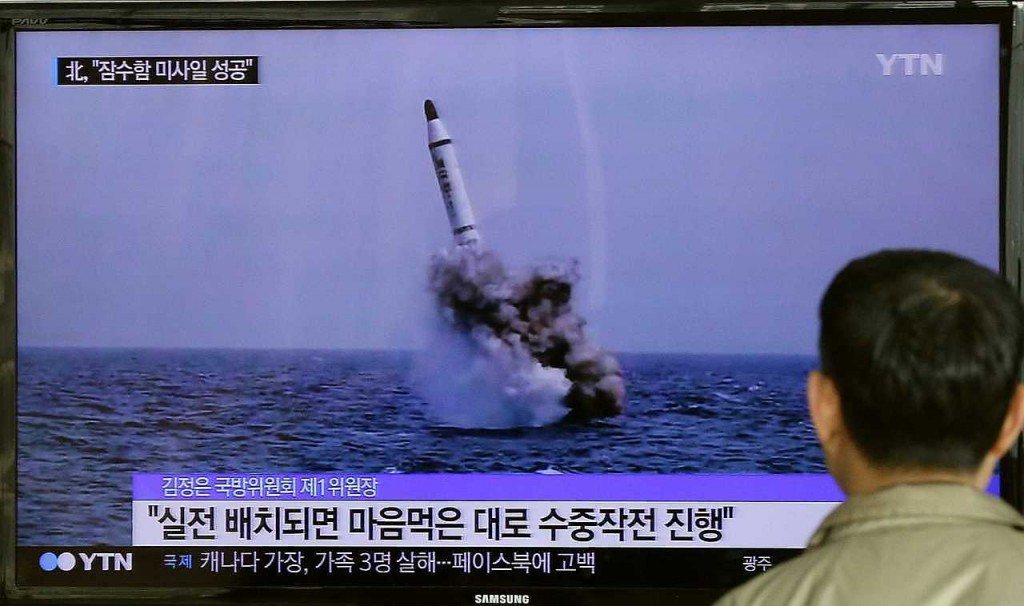North Korea claims to have launched a Submarine-Launched Ballistic Missile (SLBM) Bukkeukseong-1 (Polaris-1 or KN-11 according to the US Intelligence Community) on May 9 2015. The launch is suspected to have been accomplished from a modified Golf II-class Soviet-made Ballistic Missile Submarine that Pyongyang bought from Russia in 1994.
The launch took place off the coast of the city of Sinpo in the Sea of Japan and it was attended by the leader of North Korea, Kim Jong-un, who was on board a ship a close distance from the submerged submarine that conducted the launch. South Korea and the USA were aware since the start of 2014 of the existence of a new vertical ejection launcher which could be used for an SLBM.
The first tests of the launcher were detected by the South Korean and US secret services in January and late October 2014 at the shipyards of the of Sinpo where the North Korean engineers simulated the initial stage of boosting a missile out of a submarine launch tube. In total more than 12 tests were conducted both at sea and on shore.
The first test of the vertical ejection launcher was carried out on board a sea-based platform, while the second test was launched from a land-based static platform.
The most recent ejection test before the May 9 missile launch took place on April 22 from an underwater test platform near Sinpo, located on the south eastern coast of the country about 100 miles from the Demilitarized Zone separating it from South Korea.
Last November the semi-official South Korean news agency stated that North Korean engineers have started to refurbish a Soviet built Golf II-class (Project 629A) Ballistic Missile Submarine.
An unknown number of these submarines were bought from Russia in May 1994. The Russian Navy decommissioned them in 1990 and sold them to North Korea for scrap. The deal included 12 or 40 decommissioned Romeo, Foxtrot and Golf-class submarines.
The Golf-class submarine was designed to carry three R-21/SS-N-5 ‘Sark/Serb’ SLBMs inside three vertical tube launchers. The Soviet missile is a single stage, liquid fuel rocket system. It is 13 meters long, weighs 16.5 tons, with a diameter of 1.2 meters and an operational range of 1,650 km.
Although the Russians deactivated the missile launch tubes, according to the defense analyst Rick Fisher the North Koreans also bought several Soviet made R-27/SS-N-6 Serb SLBMs.
Based on the photos that the Korean Central News Agency released from the launch of the Bukkeukseong-1 SLBM on May 9, the North Korean missile resembles the Soviet-made R-27/SS-N-6 Serb SLBM, or the North Korean BM-25 Musudan IRBM (Intermediate-Range Ballistic Missile) which is an improved version of the R-27/SS-N-6 Serb.
State Department documents disclosed recently by Wikileaks revealed that North Korea obtained a Russian SS-N-6 Serb SLBM, that became the basis for Pyongyang’s intermediate-range BM-25 Musudan ballistic missile, several years ago, .
In the mid-1990s, North Korea invited ballistic missile designers and engineers from the Makeyev Design Bureau to develop the BM-25 Musudan IRBM based on the R-27 Zyb.
The North Korean IRBM is a liquid fuel rocket system, 12 meters long, with a diameter of 1.5 meters and a launch weigh is 20 tons. Its conventional payload is 1.200 kg, or one nuclear warhead.
The operational range of the BM-25 Musudan IRBM is 2,500-4,000 km, while the guidance is inertial with an accuracy of 1.3-1.6 km CEP (Circular Error Probability).
The next step for North Korea will be the construction of a nuclear warhead that can fit in the Bukkeukseong-1 SLBM
Regarding the North Korean submarine that launched the missile, defense analyst Rick Fisher believes that since the Chinese have built a version of the Golf-class submarine, known as the Type-031, Chinese assistance would have been crucial for North Korea to rebuild the pressure hull, modify missile tubes and to equip the sub with modern command and control systems.
Former Defense Intelligence Agency official Bruce Bechtol Jr. said North Korea is developing an SLBM as part of a plan to have missiles capable of reaching the United States, and to have missiles that will be difficult to locate for U.S. warning systems. He also noted that the upgraded North Korean submarine could possibly get within range of the continental United States, Alaska, or Hawaii.
In order to hit targets in Alaska with its SLBM, a North Korean submarine would have to sail north, close to the Russian coastline without being detected and launch the missiles from the most northern point it can reach. Alternatively it would sail south and attempt to avoid Japanese destroyers and helicopter carriers.
Both attempts could prove dangerous since an old submarine such as the Golf-class does not have a low noise signature, while the Japanese and the United States navies maintain significant naval and aerial forces in the region.
A North Korean submarine equipped with the three Bukkeukseong-1 SLBMs is a dramatic improvement for the military capabilities of Pyongyang, but it will need more that this to allow Kim Jong-un to threaten the US territory.


